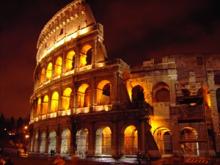Rome, Italy
The CHID Winter Rome Program offers two courses that focus intensively on the history and topography of Rome to take full advantage of Rome's unique character as an historical and urban palimpsest with multiple layers of development that transcend but include the preceding ages in an intertextual dialogue across time. The Roma Eterna course considers the historical periods of Rome as distinct "foreign" cultures that help to bring into relief the temporary and contingent character of American, and more broadly, contemporary culture and society. Rome is one of the richest sites in the world for exploring the full span of human development from the iron age hill settlements of its foundations through the Fascist appropriation of the symbols of imperial power and the attempts by contemporary Rome to assert itself as an international center of the arts through the recent inauguration of the MAXXI museum of modern art of the 21st century. The course on the Urban Structures of Rome explores in a parallel way the complex urban environment of Rome to consider how cities come to define themselves through an historical, aesthetic, and socio-economic process. Students will work with maps that reveal the evolution of Rome's urban spaces in various dimensions by first examining its ancient and imperial foundations, and then they will study in more detail the municipal districts or "rione" of Rome to engage very closely in the fashioning of urban space in all its dimensions, streets, bridges, aqueducts, monuments, piazzas, etc. These courses are intended to serve the CHID program's focus on critical consciousness through an intensified, comparative approach to historical phenomenology, and to the aesthetic structuring of urban space along with its social, cultural consequences.
The site of Rome is ideally suited to the course objectives because the historical center of Rome provides in very close proximity the convergence of multiple historical layers that allow for an ongoing comparative analysis. We will take full advantage of Rome's unique historical character through site visits four times a week linked to textual guides on the historical periods and the structural evolution of Rome.
- CHID 442: Roma Eterna (5 credits)
- CHID 471 A: Rome as a Palimpsest (5 credits)
- CHID 471 B: General Orientation to Rome (2 credits)
- CHID 471 C: Independent Study (optional 3 credits)
Note: We recommend that you check with your academic advisor to see how these courses can count toward your departmental requirements.
*Please see our Fees, Financing, and Withdrawal page for information on paying for your trip.
